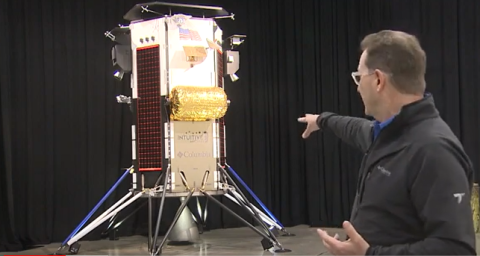
Dr. Beckham insists his work at Georgia Tech laid the groundwork for an extensive career in consulting and innovative materials research. Most recently, this led to the first commercial landing of a structure on the moon. He jumped into an academic career right after he left his undergraduate work at Auburn, going straight from his undergraduate institution to doctoral research at M.I.T., a postdoctoral fellowship at the Max Planck Institute for Polymer Research, and finally a faculty position at the Georgia Institute of Technology. Consulting during his sabbaticals led him to a gratifying and scientifically innovative position as the current VP of Innovation at Columbia Sportswear.
While he thoroughly enjoyed teaching Georgia Tech students and conducting research here, he also thought it would be valuable to bring more hands-on experience in industry settings to his pedagogy. He noticed that students benefited from learning from professors who had worked in both academic research settings and industry positions since they could share professional experience that would benefit most students–who often go on to pursue industry positions. While on sabbatical, he joined a consulting firm in addition to his active research group. He discovered he enjoyed working in the corporate environment, and rose to the challenge when interacting with attorneys to litigate and problem solve to create better products.
He said it was a tough decision to resign from his tenure track job at Georgia Tech and transition permanently to an industry position. However, he soon had a pat answer to the question his colleagues kept asking him, “Do you miss teaching?” Beckham has the perfect response: “I’m teaching every day. I didn’t really leave it behind.” Getting up in front of a room of people to teach his colleagues in the innovation department as well as more or less scientifically literate stakeholders in the industry is much the same as teaching Georgia Tech students, which I have to wonder is a nod to Georgia Tech students’ high levels of professionalism and eagerness to join the workforce. Currently, he likes to dispatch members of his team to work with Dr. Jud Ready, here at Georgia Tech, to serve as guest lecturers in his sports materials class.
In the consulting context, his expertise as an academic was an asset, of course, but he was not expecting his teaching skills to be almost as important. Teaching at Georgia Tech taught him how to modify his teaching to pitch the material to freshmen, seniors, and colleagues at conferences. This deep knowledge of adapting pedagogy to fit different situations served him well as a consultant. While before, he felt his pedagogy left students with little exposure to industrial contexts, now, he says, “I have gobs of industry stories to share with students.” The lunar mission is the most recent and impressive. His enthusiasm for seeing the tangible results of his labor is apparent in the gratitude he exudes for his professional career. He says, “It’s fun because you are helping companies solve real problems.”
In 2021, he worked with Intuitive Machines in Houston, Texas. They were looking for corporate sponsors and approached Columbia. Though they expected this union to be more of a straightforward sponsorship, it evolved into a genuine scientific partnership. You can even see Columbia’s logo on the spacecraft right above the American flag. Beckham speaks glowingly about how Intuitive Machine’s engineers worked shoulder to shoulder with the engineers at Columbia.
This spacecraft landed on February 22nd of this year, marking the first commercial company to land on the moon since Neil Armstrong first stepped on it fifty years ago. The second mission is currently planned for this October. Omni Heat Infinity was the first insulation they designed, and more insulation products are expected to be added to this delivery.
So What does a VP of Innovation do?
In short, Beckham explains, the VP of innovation evolves new materials and focuses on deliverables. Omni Heat, Columbia’s insulating technology centers the principles of “warmth, dryness, coolness, and protection.” The VP must, of course, also keep an eye on the bigger picture of the research team. For example, Columbia works in a strictly outdoor industry. Their mission is to unlock the outdoors for everyone—including people who might not otherwise have access to the outdoors. And scientific literature supports the physical and mental health benefits to being outdoors as evidenced by new fads in the U.S. such as the Japanese practice of “forest bathing.” This effort toward inclusivity includes a wider range of price points than similar sportswear companies, allowing people in lower income ranges to obtain a quality product.
Dr. Beckham emphasizes with a sense of urgency, “the fundamentals you learn here prepare you to build products for the real world.” He wants to remind students not to forget these fundamentals since they are the foundation upon which innovation stands. He insists on leaving students with this message, “The fundamentals really matter … Don’t forget your fundamentals. The fundamentals you learn here at Georgia Tech will allow you to build any product that will help solve the problems of the future.”